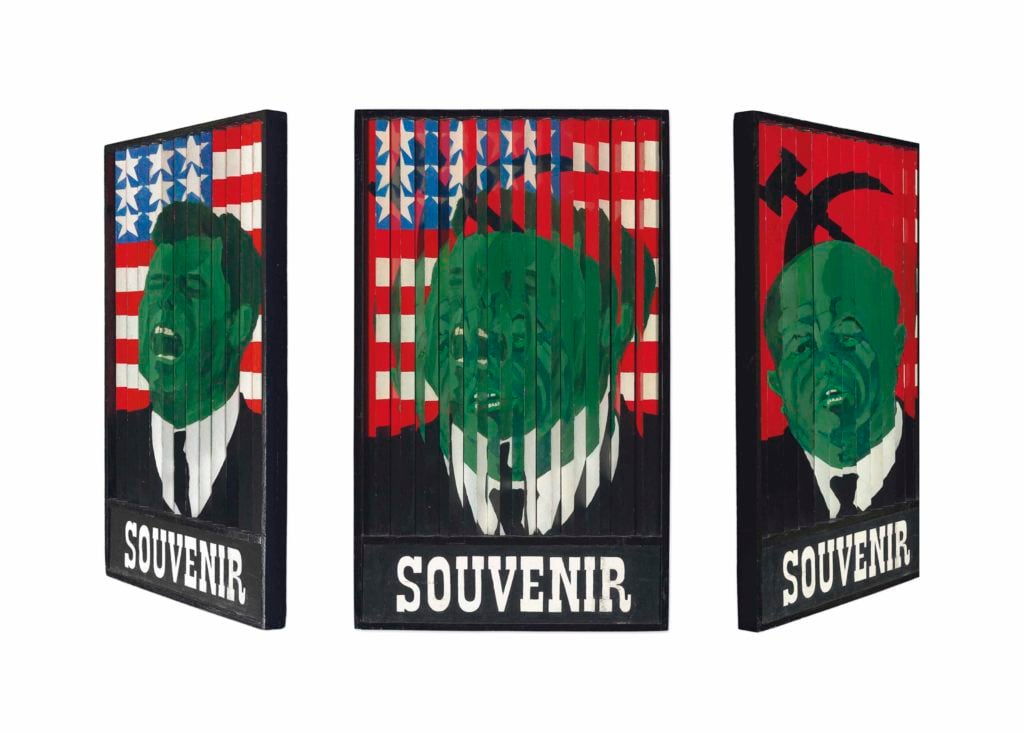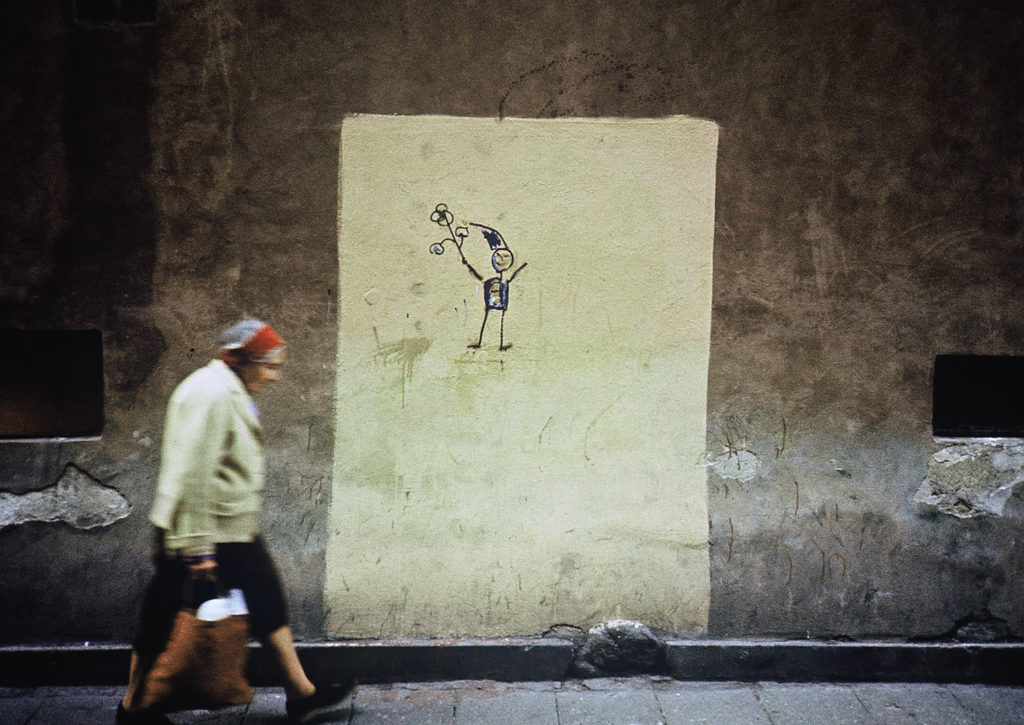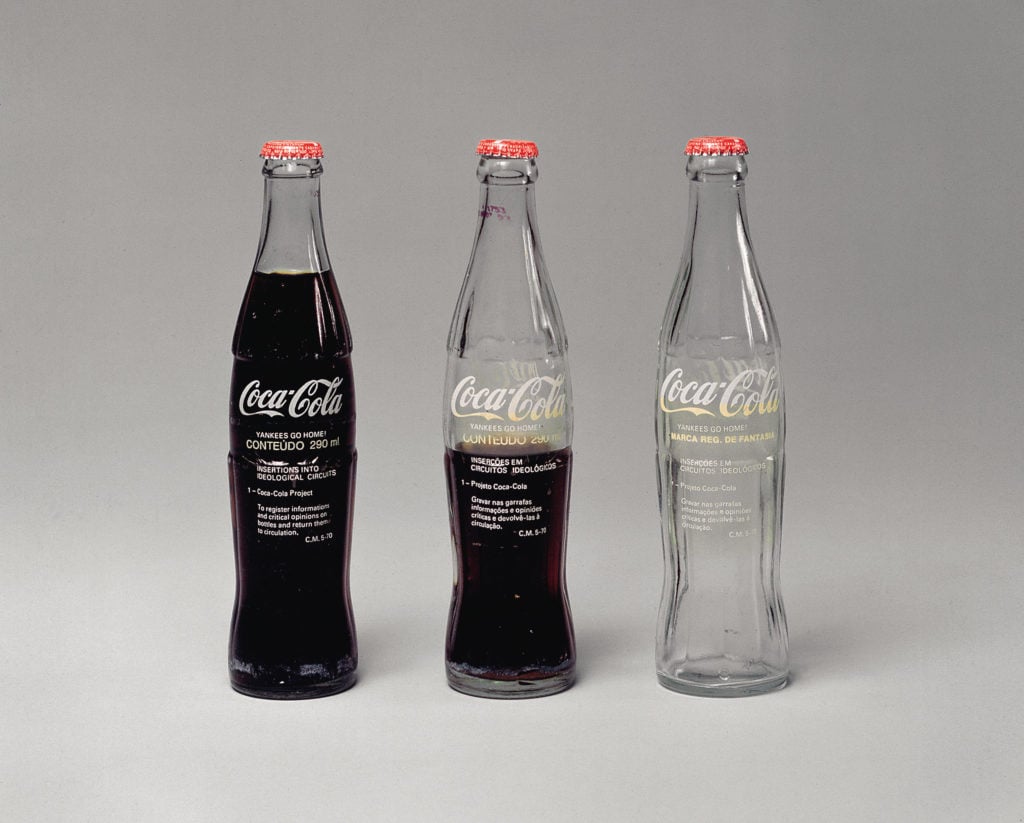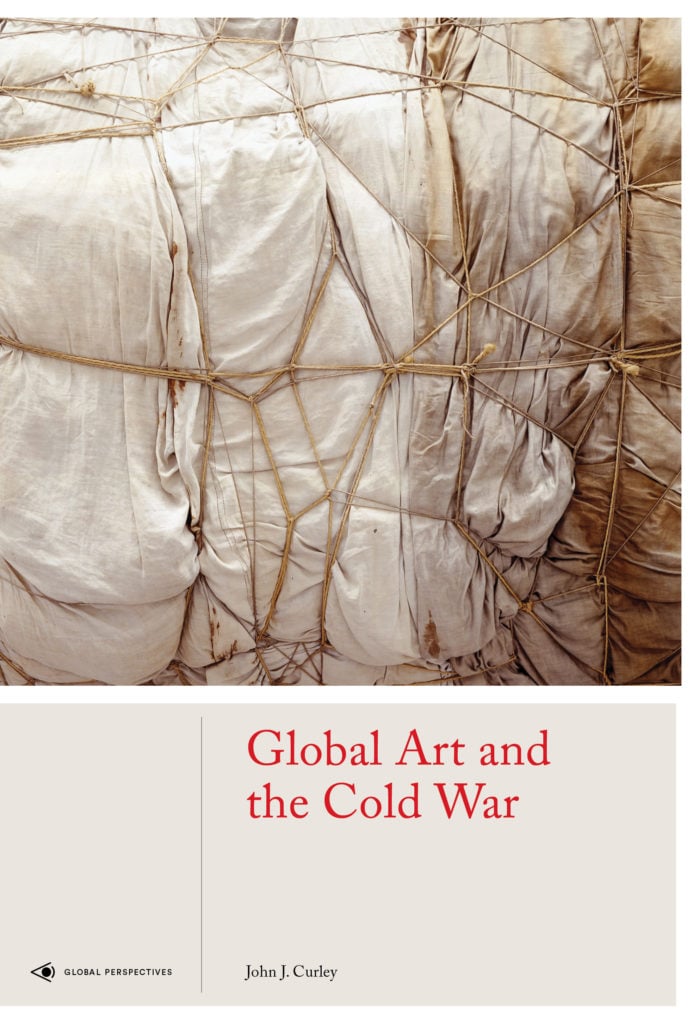Politics
What the Cold War Can Teach Us About How Art Shapes Politics in Times of Conflict
A new book by John J. Curley sheds light on the role that images played in the Cold War.

A new book by John J. Curley sheds light on the role that images played in the Cold War.

A painter introduced one of the Cold War’s most enduring, powerful, and popular metaphors: the Iron Curtain. Winston Churchill—a passionate and prolific amateur painter in addition to his role as British prime minister and international statesman—invoked the term in 1946, in a speech given in Missouri, with American president Harry Truman in attendance:
…an iron curtain has descended across the continent. Behind that line lie all the capitals of the ancient states of Central and Eastern Europe. … [A]ll are subject, in one form or another, not only to Soviet influence but to a very high and, in many cases, increasing measure of control from Moscow.
Churchill’s Iron Curtain provided a vivid image of a fiercely divided Europe after World War II. To the east, in countries like Hungary, Poland, Czechoslovakia, and what was soon to become East Germany, the Soviets imposed communist rule. And in the Western half of Europe, the nations of France, Great Britain, Italy, and the future West Germany aligned themselves with the United States and at least the basics of its capitalist economic system. For more than 40 years, Churchill’s provocative image defined the Cold War’s binary logic, even encompassing the world beyond Europe, save for those nations that attempted to remain neutral. In the popular imagination, people and goods passed through the barrier only with great difficulty. It is not hard to imagine how Churchill’s Iron Curtain became conflated with the Berlin Wall when it was erected in 1961. Metaphor became reality.
While the global situation was more complicated, this binary conception of the world nevertheless wielded significant historical consequences. The Cold War is the central story of the second half of the twentieth century—essential for explaining what happened around the world and why. Even disputes that, at their start, had little or nothing to do with the Cold War, morphed into important battlegrounds for the conflict. But what was the Cold War? Put very simply, it was the ideological battle between the United States and the Soviet Union (and their respective allies) that started at the end of World War II in 1945 and ended with the fall of the Berlin Wall in 1989 and the subsequent dissolution of the Soviet Bloc.
While both nations had fought together in World War II to defeat Nazi Germany, each rushed in to fill the vacuum left by Hitler’s defeat and the resulting political upheaval, and did so with their own interests in mind. Who would control the reconstruction of postwar Europe? Would it be rebuilt to reflect American-style democratic capitalism or Soviet-style socialism? These questions lay at the heart of the Cold War’s origins, and they also carried great consequences beyond the continent, as Japan’s defeat in World War II left its own void in Asia, and Western powers became unable or unwilling to maintain their hold on colonies or client states in Asia, Latin America, and Africa. In the eyes of the two superpowers, other nations—whether new or old—needed to choose sides in the Cold War.
The conflict intensified by 1948 and remained fierce until its end, though a period in the 1970s, known as détente, saw the renewal of diplomatic relations and the signing of agreements between Cold War adversaries. Even a short list of major events of the Cold War can bring back a sense of the period’s anxiety and tension: the Korean War in the early 1950s; Soviet invasions to quell democratic protests in East Berlin (1953), Budapest (1956), and Prague (1968); the failed CIA-orchestrated invasion of Cuba known as the Bay of Pigs in 1961; successful CIA-backed regime changes in Iran (1953), Guatemala (1954), Congo (1960), as well as at least condoning others such as Brazil (1964) and Chile (1973); the Cuban Missile Crisis in 1962; the Vietnam War, which dominated the mid- to late 1960s, as well as other postcolonial conflicts subsumed by the Cold War; and the Soviet invasion of Afghanistan in 1979. Looming over all these events, as well as more “minor” ones, was the threat of nuclear apocalypse. By 1949 both sides had the Bomb, and by the mid-1960s possessed sufficient weaponry to end the world many times over. Thus even small flare-ups evoked existential questions of life and death on the scale of the human species itself.

The Polish anti-authoritarian movement Orange Alternative made this graffiti dwarf a revolutionary symbol. Photo by Tomasz Sikorski.
The Cold War pitted two so-called “master narratives” against each other. Did capitalism, with its discourses of private property and individual choice, represent the highest form of human organization? Or was communism—which had denounced class-based hierarchies and the profit motive—the more evolved philosophy? Capitalism and communism have common roots. Both are products of Western modernization, and both rely on utopian notions: The former promises individual choice and the possibility that anybody can become wealthy, and the latter claims as its goals—equality, meaningful labor, and collective life without greed. In this sense, the Cold War was waged over the meaning of “progress,” and was as much a semantic battle over language and the interpretation of the world, as it was a political–military struggle. And when, by the end of the 1960s, the illusions of both utopian visions seemed to be violated, whether by Soviet tanks in the streets of Prague, or American bombs in Vietnam, the very terms of the Cold War’s existence came under interrogation. The conflict’s empty rhetoric and false oppositions—abundantly clear by the end of 1968—encouraged advanced thinkers, such as Jacques Derrida, to suggest the relativity of all ideologies and the illusionary nature of binaries. Put simply, the Cold War helped spur postmodernism, as the art of the 1970s and beyond demonstrates.
As the Cold War progressed, countries well beyond Europe were forced to engage, wittingly or unwittingly, with this binary imposed by the two global superpowers. Some chose sides based on ideology or more practical concerns such as the promise of economic aid; others had the decision made for them, whether through military action from outside or through internal coups secretly engineered by American or Soviet officials. Countries that attempted to remain neutral often found themselves drawn into Cold War political battles despite their best efforts. The doctrine of containment, formulated by the American diplomat George Kennan at the start of the Cold War, reiterated Churchill’s Iron Curtain metaphor. Sending a long cable from Moscow in 1946, Kennan advocated preventing further Soviet territorial and ideological advances through containment: Communism, not unlike a disease, could be controlled by quarantine. This idea loosely guided American foreign policy for the length of the conflict. With its connotations of strict demarcation, the term became a metaphor for the Cold War more broadly—a world divided into two distinct camps with no overlap.
The Cold War’s binary rhetoric failed, however, to describe reality accurately: Local situations demanded more nuanced and specific understandings. For example, in the Vietnam War, many soldiers in the communist north were fighting for national independence and self determination, not for the ideological reasons usually ascribed to the conflict. Initially, the Vietnamese communist leader Ho Chi Minh even looked to the United States as a model for its own anti-colonial revolution, identifying Americans as the “guardians and champions of world justice” in a letter to President Harry Truman in 1946. Such anti-colonial sentiments, not Cold War beliefs, likewise fueled many Afghan “freedom fighters” in their war against the Soviets in the 1980s. Many of these anti-Soviet soldiers soon also became anti-American. In 1988, some of them founded Al-Qaeda, the primary enemy of the United States in the years before and following the terrorist attacks on September 11, 2001—thus confirming divergent reasons for wanting the Soviet presence out of Afghanistan. The Cold War was thus a way of seeing the world. This ideological lens transformed complex constellations of global and local events into a manageable framework: Soviet communism versus American capitalism. The visual qualities suggested by the phrase “ideological blindness”—a phrase that came into popular use at the very start of the Cold War, describing how rigid political beliefs can twist perception and interpretation in irrational ways—leads to a consideration of the importance of images, specifically art, to the conflict.
The British Pop artist Gerald Laing addressed the very issue of ideological blindness in an important painting from late 1962 entitled Souvenir (of the Cuban Missile Crisis Oct 16–28 1962), featuring both protagonists of the global showdown over the presence of Soviet missiles in Cuba: John Kennedy and Nikita Khrushchev. Because the work is painted on angled vertical slats, viewers see an image of Kennedy and an American flag when they are to its right, but from its left they encounter Khrushchev in front of the Soviet standard. Both representations take the form of simplified political propaganda, more reminiscent of caricatures than carefully studied portraits. In addition to mapping Cold War sides onto physical space, determined by the viewer’s position in the gallery, Souvenir dramatizes how viewers can interpret the same painting in radically different ways: Once one understands how the painting works, one can choose to see Kennedy or Khrushchev.
However, we should also consider the effect of the painting when viewed straight-on, which is how most people typically approach a work hanging on a wall. From this perspective, the painting is literally pulled in two ideological directions, resulting in a jumbled mess—almost like a period television flickering between two stations. The painting suggests that the fiercely partisan view imposed by the Cold War is not a natural way to regard the world; individuals have to look at the painting askance—stepping away from a more natural exercise of one’s vision—to see an uncomplicated representation of the leaders of capitalism and communism. The painting’s central view better represents the everyday experience of the Cold War, especially in countries other than the Soviet Union and the United States: a resistance to aligning oneself rigidly on either side of the conflict. Between the two poles, reality was contentious and scrambled. In 1957, just a few years before Laing painted his canvas, the French filmmaker Chris Marker made a similar point in his documentary Letter from Siberia when he repeated footage of road workers in a Siberian city three times, each with a different voice-over: one from a staunchly Soviet perspective, one from an American one, and the third straddled between the two. Marker’s film exposes the way that even “objective” imagery—whether in photographs or films—can be twisted by narration or captions.
One of the 20th century’s most consequential photographs can help clarify the stakes of Laing’s painting in terms of its relation to the Cuban Missile Crisis, as referenced in its title. At first glance, the high-altitude photograph—featuring a landscape with fields, trees, and roads—does not seem especially interesting, at least not without captions to explain or contextualize it. This photograph, however—taken by an American U-2 spy plane high above communist Cuba on October 14, 1962—proved to be a crucial piece of evidence. Analysts at the National Photographic Interpretation Center in Washington, examining miles of photo transparencies with visual aids, found important needles in a giant intelligence haystack: the subtle visual signatures of offensive Soviet missile systems. This photograph helped establish that the Soviets were secretly installing nuclear weapons in Cuba.
US government officials needed this image to be perceived as a truthful document across the world, and soon made it, as well as other similar photos, public. But the picture itself, especially when stripped of the captions supplied by professional interpreters, proves nothing to untrained eyes. When first shown this image and others at the White House, President Kennedy suggested that one of the sites in question looked like a “football field,” not a missile site. A high-ranking CIA official even admitted that any non-specialist would have to take it “on faith” that the image showed what its captions said it did. So while this picture helped prove to the world (and the United Nations) the existence of offensive missiles in Cuba, it is shocking that this nearly abstract photograph—and other similar examples—were never seriously questioned publicly. The perceived certainty of the image’s captions suppressed its pictorial ambiguity.

Cildo Meireles, Insertions into Ideological Circuits: Coca Cola Project (1970).
In the early years of the Cold War, the art historian E.H. Gombrich remarked that what viewers bring to an image—including their visual training and political ideology—helps dictate how that image is interpreted. Gombrich called this automatic “completion” by the viewer, “the beholder’s share.” In terms of the Cold War, a Soviet viewer would more likely be skeptical about the validity of images taken over Cuba than an American would, for example. Ideology had always guided the interpretation of images, but perhaps never yet on the Cold War’s systematic, global scale. While an extreme case, this aerial surveillance photo highlights not only a missile crisis but also a broader image crisis in the Cold War. Important examples were not only ambiguous, but were also interpreted through ideological filters as “fact.”
When discussing art, Winston Churchill seems to have understood the fluid nature of images. While certainly not an avant-garde painter, he viewed painting as an activity where the quirks and ambiguities of vision could be explored. He addresses this notion in “Painting as a Pastime,” an essay from the early 1920s, published as a stand-alone book soon after his Iron Curtain speech. In a remarkable passage that Gombrich also discussed in his book Art and Illusion (1960), Churchill describes painting in conspiratorial terms:
The canvas receives a message dispatched usually a few seconds before from the natural object. But it has come through a post office en route. It has been transmitted in code. It has been turned from light into paint. It reaches the canvas [as] a cryptogram. Not until it has been placed in its correct relation to everything else that is on the canvas can it be deciphered, is its meaning apparent, is it translated once again from mere
pigment into light.
If Churchill’s view of the geopolitical world was bound by the absolute nature of the emerging Cold War binary, then his understanding of painting was decidedly more nuanced. His painter is certain neither about representation nor the stability of the visual world; instead he or she resembles a spy who waits for enigmatic letters to arrive, decodes these “cryptograms,” then translates them into a specific language of painting. A consideration of Churchill’s words on painting, in tandem with his “Iron Curtain” speech, reveals a complex fluidity lurking just beneath his image of a simple binary world. And by theorizing the medium via a language of image transmission (images are “dispatched” and “come through a post office”) he relates painting to other image cultures that were used propagandistically on both sides during the Cold War: press photographs, television screens, and satellite images. Images—even those that are presented as stable and factual—can be flexible, contradictory, and changeable. Or to use the popular language of the Cold War, images—including works of art—can be spies that hide secrets in plain sight. It may be no coincidence that one of the most infamous Soviet spies in this period was the renowned British art historian and Queen’s curator Anthony Blunt. Blunt’s activities included serving as the courier for a key Soviet asset inside the British secret service, and probably alerting Britain’s most notorious double agent of the period, Kim Philby, of his imminent arrest, allowing Philby to escape to Moscow from Beirut. Blunt’s understanding of the mutability of images—how paintings can house and manage contradictions, ideological and otherwise—might have provided a model of deception that allowed him to work undetected for years.

The cover of Global Art and the Cold War by by John J. Curley.
Despite the apparent certainty of Churchill’s anti-communist political position—which divided the world between absolute good and absolute evil—his theory of art works against such binary conviction. And yet Churchill’s apparent contradiction was consistent with the functioning of the conflict. Cold War factions required certainty in their messages, and yet such clarity, whether visual or ideological, was impossible to achieve.
Some thinkers from the period understood the conflict in such a way—as one fought at the level of representation. As media theorist Marshall McLuhan wrote in 1964, the Cold War was “really an electric battle of information and images.” Because there were no direct, sustained military confrontations between the United States and the Soviets (other than proxy wars like Vietnam and Afghanistan), the conflict was largely waged on the level of intelligence gathering and media representations—propagandistic efforts from both sides to convince the world, and perhaps themselves, of the correctness and historical inevitability of their respective paths. Even nuclear deterrence was predicated on conveying a credible image of nuclear strength and was not necessarily dependent on the actual number of weapons. And things were rarely what they seemed in this battle of images, as Cold War historian John Lewis Gaddis suggested when he compared the conflict to a theater in which “distinctions between illusions and reality were not always obvious.” Pioneering Cold War art historian Serge Guilbaut recently agreed with such an assessment, comparing the conflict to an “almost Hollywood super-production.” While some art objects served ideological ends, many works of art from the period pulled back the Iron Curtain to expose the limits and dangers of the Cold War’s superficial and overly simple binaries.
Excerpted from Global Art and the Cold War by John J. Curley. Copyright © 2019 by John J. Curley. Excerpted by permission of Laurence King Publishing Ltd. All rights reserved. No part of this excerpt may be reproduced or reprinted without permission in writing from the publisher.